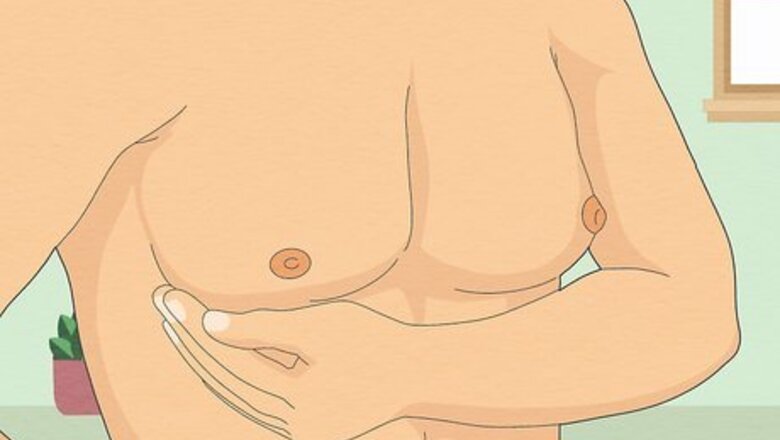
views
X
Trustworthy Source
PubMed Central
Journal archive from the U.S. National Institutes of Health
Go to source
While gynecomastia is harmless and usually goes away on its own, it can be uncomfortable, scary, or embarrassing. In some cases, it may be a symptom of a more serious condition. In this article, we’ll tell you how to recognize the symptoms of gynecomastia and get a medical diagnosis. We’ll also guide you through the most common risk factors and treatment options.
- A tender lump behind your nipple is the most common symptom of gynecomastia.
- See your doctor for a diagnosis if you think you have gynecomastia.
- Although gynecomastia isn’t harmful, it can be a symptom of a more serious condition.
- Gynecomastia often goes away on its own, but if it doesn’t, your doctor may prescribe medications or surgery.
Recognizing the Symptoms of Gynecomastia
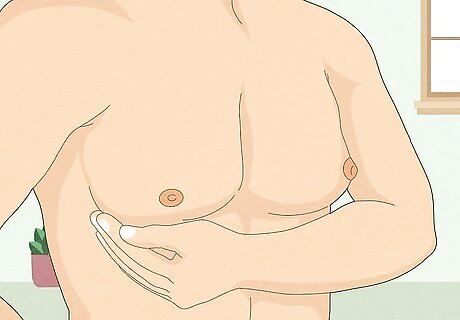
Feel for soft lumps in your breasts. In true gynecomastia, glandular breast tissue develops in one or both breasts. This tissue may be located directly behind the nipple. Gently feel your breast with your fingertips. If you have gynecomastia, you should feel a soft, rubbery lump in one or both breasts. If you feel a lump in your breast, go to the doctor immediately. A hard lump may be a tumor. Gynecomastia may occur in just one breast or both breasts at once. The size of the lump can vary and may not be the same in both breasts. Breast buds in puberty-aged males are typically the size of a nickel or quarter.
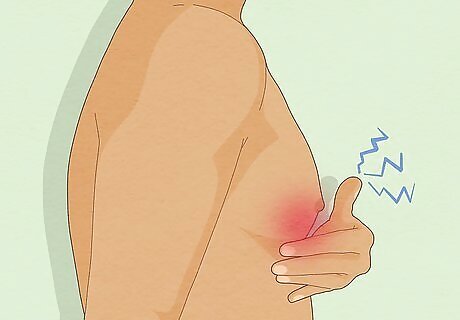
Make note of tenderness. Gynecomastia may cause soreness, especially when you touch or press on your breast. If your breasts are causing you a lot of pain or discomfort, make an appointment to see your doctor right away.
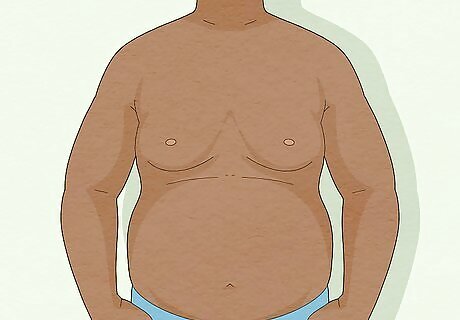
Check for soft fatty tissue to find out if you have pseudogynecomastia. True gynecomastia is different from breast enlargement caused by a buildup of fat in the chest. If your breasts are enlarged and soft to the touch, but you do not feel tenderness or a lump in your breast or behind your nipple, you may have pseudogynecomastia. This condition usually goes away with weight loss. It is possible that being overweight can also contribute to the development of true gynecomastia, since fatty tissue tends to boost the body’s production of estrogen.
Assessing Your Risk of Gynecomastia
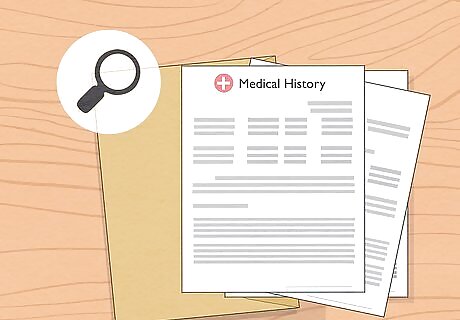
Look at your health history. Some people are at a higher risk of developing gynecomastia than others. Consider your age, medical history, and overall health. You are more likely to develop gynecomastia if you: Are going through puberty or are between 50 and 69 years of age. Newborns can also develop gynecomastia. Infant gynecomastia usually goes away on its own before the child is a year old. Have a condition that affects your body’s ability to produce testosterone, such as pituitary insufficiency or Klinefelter’s syndrome. Have a liver condition, such as cirrhosis or liver failure. Have a hyperactive thyroid gland. Have certain types of tumors, especially in the pituitary gland, adrenal gland, or testes.

Note any medications you are taking. Certain types of prescription drugs can cause gynecomastia. You may be at risk if you are using: Medications to treat an enlarged prostate or prostate cancer. Anabolic steroids. Some types of AIDS medications. Tricyclic antidepressants. Certain types of anti-anxiety medications, such as diazepam. Some types of antibiotics. Certain heart medications, such as digoxin. Gastric motility medications, like metoclopramide.

Check for plant oils in your body care products. Some plant oils, such as lavender and tea tree oil, contain natural chemicals that mimic the estrogen hormone. These oils may cause gynecomastia to develop in some men. Check the ingredient labels on your soaps, shampoos, body lotions, aftershave, and other common products for plant oils. Gynecomastia caused by plant oils should go away shortly after you stop using products containing these oils.

Examine any drug use habits. Recreational drugs such as alcohol, marijuana, amphetamines, heroin, or methadone may cause gynecomastia in some men. If you use any of these drugs and are concerned about developing gynecomastia or other health problems, work with your doctor to determine the healthiest way to cut back or stop using the drug(s) altogether.
Getting a Diagnosis from Your Doctor

Make an appointment for an exam. If you think you might have gynecomastia, see your doctor. While gynecomastia itself is not dangerous, you should have it checked out to make sure it is not a symptom of something more serious. See your doctor immediately if you have any other troublesome symptoms, such as: Pain and swelling in your breasts. These are common symptoms of gynecomastia, but could also be caused by a cyst or infection. Discharge from one or both nipples, which could be a sign of a condition such as breast cancer, an infection of the breast tissue, or an endocrine disorder. A hard lump in your breast, which may be a sign of breast cancer.

Discuss your health history with your doctor. It will be easier for your doctor to diagnose your condition if they have thorough information about your overall health and medical history. Your doctor may ask about: Any other symptoms you may be having. Any history of related health problems in your family. Any other medical problems you have had in the past. What medications, drugs, dietary supplements, or body care products you might be using.

Get tests done to diagnose gynecomastia and rule out other issues. Your doctor will do a physical exam to determine if gynecomastia is likely. If they detect symptoms of gynecomastia, they may order further tests to determine the cause of the condition and rule out more serious problems. These tests may include: A mammogram. Blood tests. CT scans, an MRI, or a chest X-ray. A testicular ultrasound. A biopsy of your breast tissue if cancer is suspected.

Ask your doctor about treatment options. In many cases, gynecomastia will go away on its own with time. However, if your gynecomastia does not clear up on its own, or if it is causing you a lot of pain or distress, your doctor may recommend one of the following treatments: Hormone therapy Treatment of the underlying cause Stopping or adjusting any medications that might be causing the problem Liposuction to remove excess fat from the breast Mastectomy, a type of surgery in which the glandular tissue of the breast is removed
Treating Gynecomastia

Wait for it to go away on its own if your doctor recommends it. The good news is that in many cases gynecomastia clear up without any need for treatment. This is especially common in teens and young adults, who usually develop gynecomastia because of hormone changes caused by puberty. If this is the case for you, your doctor will probably recommend keeping a close eye on your condition and getting regular exams to monitor your progress. Your doctor may recommend getting an exam every 3-6 months until the gynecomastia begins to go away, and then once a year after that. Gynecomastia caused by puberty hormones often clears up within 1 to 2 years without any treatment.

Treat the underlying cause. If there’s some other medical condition causing your gynecomastia, treating the root issue may clear up the gynecomastia as well. Your doctor can help you figure out what’s causing the issue and talk to you about the best treatment options. For example, gynecomastia can be caused by an overactive thyroid gland. In these cases, your doctor might recommend medications or surgery to block your thyroid gland from producing too many hormones. Sometimes medications used to treat another condition can cause gynecomastia. Ask your doctor about adjusting your dose or switching to a new treatment if your medication is causing the issue. If your gynecomastia is caused by recreational drug use, your doctor can give you advice about how to safely quit.
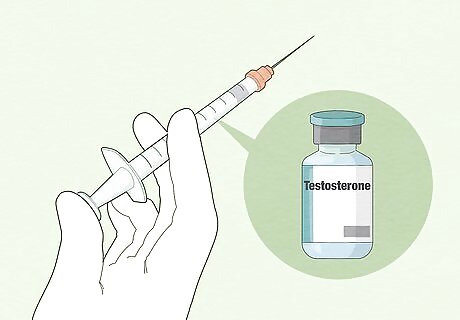
Discuss hormone therapy with your doctor. If your gynecomastia doesn’t go away on its own and there’s no obvious medical cause, your doctor might recommend hormone treatments. Ask your doctor about the possible risks and side effects of these treatments. They can help you decide if hormone treatments are the best and safest option for you. Your doctor may prescribe androgens (sometimes called “male hormones”) if they think your gynecomastia is caused by low androgen levels. If your gynecomastia is caused by high estrogen (“female hormone”) levels, they may recommend estrogen-blocking medications. Hormone therapy can have serious risks and side effects, especially if you have certain pre-existing medical conditions or if you use certain medications or recreational drugs. Be honest with your doctor about your habits and health history before starting one of these treatments.
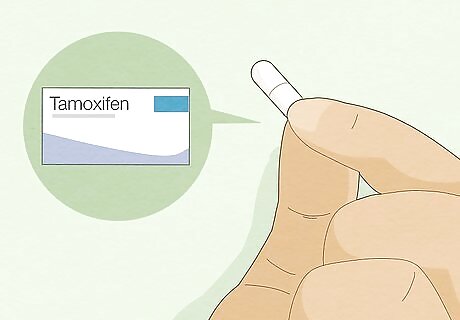
Look into other medications that may help. Some medications that are normally used to treat other conditions can also help with gynecomastia. Your doctor may recommend these treatments alone or in combination with hormone therapy. Some common options include: Tamoxifen, a medication that’s normally prescribed to treat breast cancer that has spread to other parts of the body. It is sometimes prescribed to help treat or prevent gynecomastia that’s caused by treatments for other conditions (such as antiandrogen medications for prostate cancer). Aromatase inhibitors. This is a specialized type of hormone-blocking medication that was originally developed to treat breast cancer.
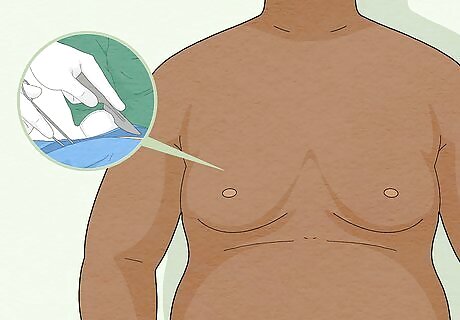
Ask your doctor about surgical options. If your gynecomastia isn’t going away on its own and other treatments aren’t working, talk to your doctor about getting surgery. They can help you decide which type of surgery is best for you. Follow your doctor’s pre- and post-surgery instructions carefully to help ensure that your procedure is as safe and effective as possible. The most common surgical treatments for gynecomastia are: Liposuction, in which the fat in the breast is removed to reduce overall breast size. This won’t treat the enlarged glands in your breasts. Mastectomy, a surgery in which the glandular tissue is removed from the breasts.














Comments
0 comment